Morris & Fan. Reservoir Sedimentation Handbook
Подождите немного. Документ загружается.

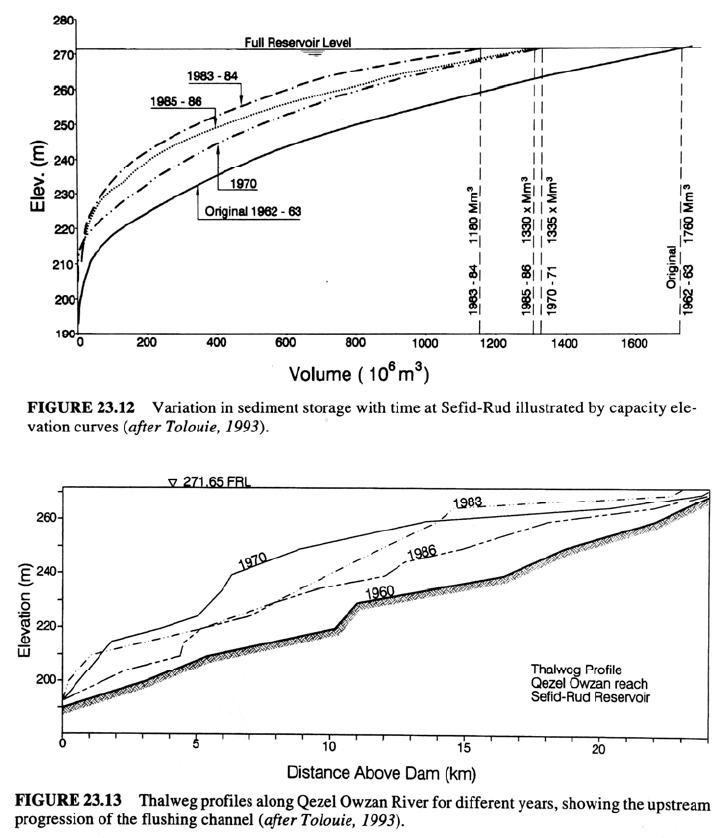
CASE STUDY: SEFID-RUD RESERVOIR, IRAN 23.13
The capacity elevation curves and thalweg profiles shown in Figs. 23.12 and 23.13
illustrate the rapid storage loss and subsequent recovery achieved with flushing.
Because of channel formation, significant capacity was recovered at all active storage
levels within the reservoir. Sediments were eroded during flushing by three processes:
sheet erosion, channel erosion, and bank failure. Only the latter two processes were
significant.
23.4.2 Sheet Erosion
During the desiltation operation in 1980-1981 the most important type of erosion was
sheet flow and scour of recently deposited, unconsolidated fine sediments from within
5 km of the dam. This was the first year of drawdown, and sediments on the top of the
bed below 240 m had not been previously dewatered. Because of the high rate of sheet
CASE STUDY: SEFID-RUD RESERVOIR, IRAN 23.14
erosion during the first flushing event, during the second year of flushing the reservoir
level was raised and lowered several times between pool elevations 215 and 220 m to
accelerate sheet erosion, but after 2 months, sediment concentration in the discharge had
dropped to only 0.9 g/L and the procedure was stopped. Overall, sheet erosion was of
little importance after the first flushing event and was always limited to only a small
fraction of the sediments deposited on the submerged floodplains during the preceding
impounding period.
23.4.3 Channel Erosion
The most important sediment removal process was channel erosion. Soon after the first
complete drawdown in 1982-1983, main channels were eroded, extending upstream
from the bottom outlets along both the Qezel Owzan and Shahrud Rivers, and these
channels quickly deepened and widened as flushing continued. Because of the presence
of cohesive sediments, very steep banks were formed. Massive bank slides occurred
during the first month after complete drawdown and the magnitude of channel erosion
was very sensitive to changes in flow rate. If the channel became relatively stabilized at
one discharge, a subsequent larger discharge would renew accelerated bed and bank
erosion. The photograph in Fig. 23.14 illustrates the general appearance of the flushing
channel in layered sediments during the active erosion period, showing collapsing banks
of cohesive material after erosion of underlying sandy deposits by piping.
Referring to the sequence of thalweg profiles in Fig. 23.13, one can see that channel
deepening initially occurred near the dam and moved upstream by retrogressive erosion.
23.4.4 Turbidity Currents
During impounding, the main flushing channels within the deposits produced a
submerged gorge along which turbidity currents could travel, thereby improving the
potential to release sediments through bottom outlets at the dam. However, because
sediment can be removed by flushing, priority was not given to venting turbidity
currents. Sediments in turbidity currents deposited in the channels are removed by
flushing.
23.4.5 Outflow Sediment Concentration
Instantaneous suspended-sediment concentrations as high as 670 g/L were measured
downstream of the dam during flushing. The concentration and amount of sediment
transported out of the reservoir depends on sediment delivered from the watershed and
deposited in the flushing channel, the rate of sediment entrainment from the deposits,
and the sediment transport capacity of the streamflow. The main channel was formed
during the first 3 years of flushing, and these years were the period of maximum
sediment export and increase in reservoir capacity. After the main channel has become
relatively stable, most sediment removal involved material deposited in the channel
since the previous flushing, or material eroded from the floodplain deposits using
auxiliary methods such as lateral or longitudinal erosion (diversion channels).
Although the greatest volume of sediment is removed during the initial period of main
channel formation, the data in Table 23.4 indicate that the maximum sediment
concentrations occur after the main channel has been formed. This is caused by the rapid
mobilization of unconsolidated sediment deposited along the main channel during the
preceding impounding period.
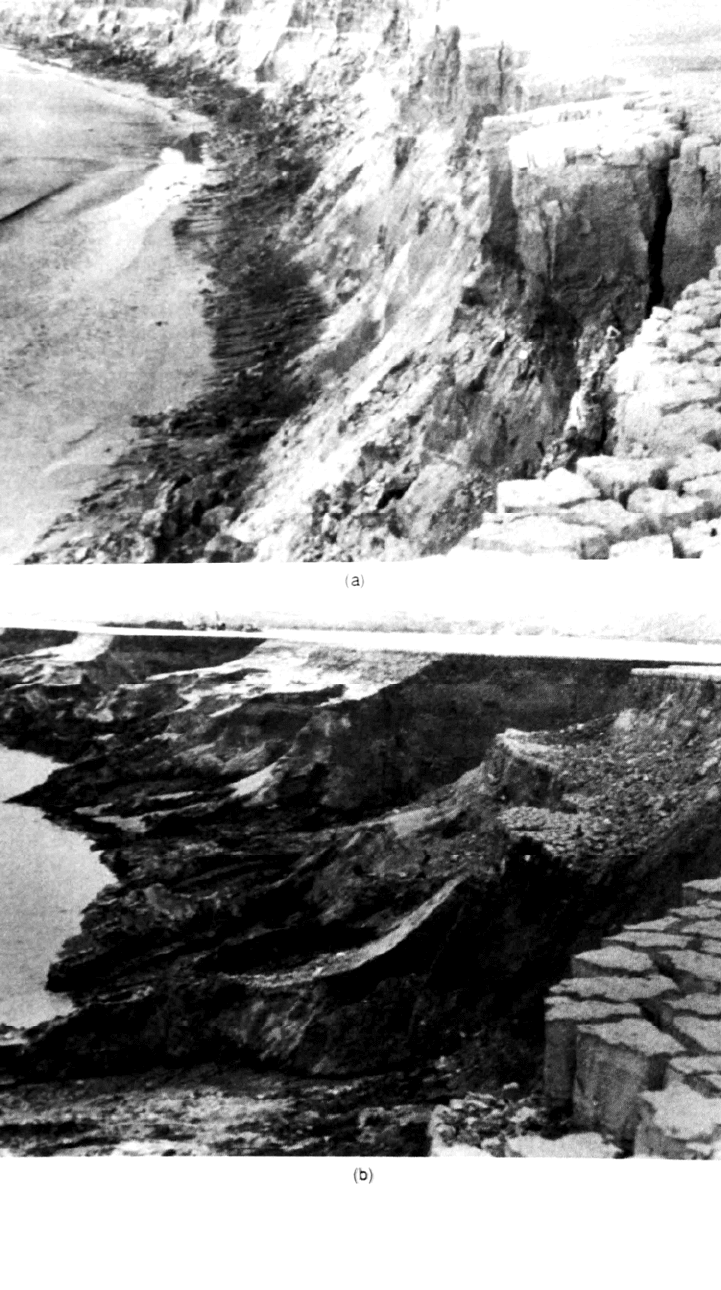
CASE STUDY: SEFID-RUD RESERVOIR, IRAN 23.15
FIGURE 23.14 (a) Photograph of main channel formation showing erosion of sand
sublayer by seepage. (b) Bank collapse due to erosion of the sand sublayer, forming terraces and
gullies.
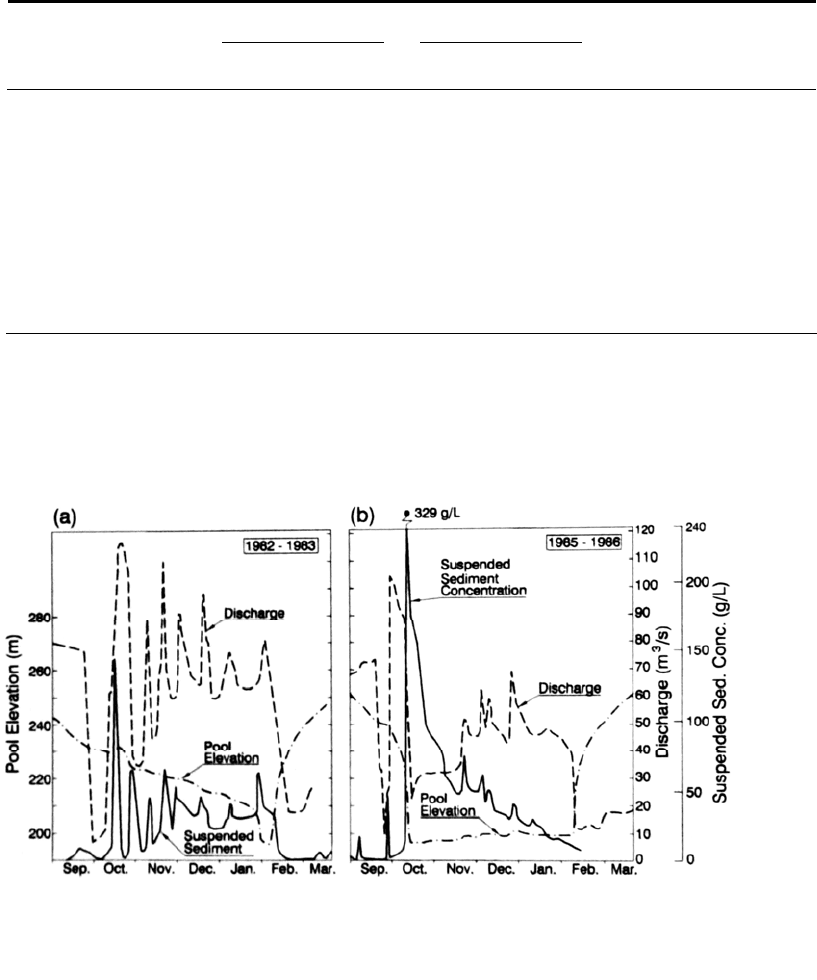
CASE STUDY: SEFID-RUD RESERVOIR, IRAN 23.16
TABLE 23.4
Maximum Daily Suspended Sediment Release during Each Flushing
Season, Sefid-Rud Reservoir
Pool
elevation,
m
In
flow Outflow
Water
m3
/s
SS,
10
3
t/day
Water,
m
3
/s
SS,
10
3
t/day
Date
Drawdown
rate, m/day
Max. daily ave.
SS concentra-
tion, g/L
Nov. 9, 1980 216 61 31 105 967 3.9 107
Oct. 3. 1981 223 28 1 160 981 2.6 71
Oct. 10, 1982 229 239 503 182 1927 0.3 122
Dec. 14, 1983 201 136 70 154 2342 4.1 176
Dec. 3, 1984 205 205 106 266 7918 6.1 344
Oct. 4, 1985 210 27 0.5 165 2905 8.6 204
Nov. 20, 1986 197 81 14 129 3256 11.2 292
Nov. 20, 1987 198 87 7 213 5617 16.5 305
Oct. 24, 1988 200 89 41 135 4639 6.0 398
The reservoir attained full drawdown for the first me in February 1983.
SS = suspended solids
Source: After Tolouie (1993).
The variation in pool elevation, water discharge and sediment discharge during
1982-1983, the first year in which complete emptying was achieved, is illustrated in Fig.
23.15a. The maximum instantaneous suspended-solids concentrations of 150 g/L down-
stream of the dam occurred during this first full drawdown event when a large discharge
occurred after a period of gate closure, and probably included a significant amount of
material that had accumulated in front of the outlets. As the pool was lowered and
discharge varied, suspended sediment spikes downstream of the dam closely tracked the
discharge spikes, with erosion within the reservoir generally increasing as a function of
FIGURE 23.15 Variation in pool level, discharge, and sediment concentration during two
flushing events, Sefid-Rud Reservoir: (a) during first year (b) after stabilization. (after Tolouie.
1989).

CASE STUDY: SEFID-RUD RESERVOIR, IRAN 23.17
discharge. A final sediment concentration peak occurred when full drawdown was
achieved. A high rate of sediment discharge and continuously elevated suspended
sediment concentrations occurred throughout this entire flushing period while the
main channel was being formed.
The situation was quite different only 3 years later during the 1985-1986
flushing season when the main channel had become more stabilized (Fig. 23.15b). In that
year, the reservoir level was dropped from 220 to 196 m over only a few days
creating a very high rate of sediment release. Suspended-solids concentration
exceeded 150 g/L for about 1 week and reached a maximum value of 329 g/L.
However, the solids content of the water released from the dam declined steadily,
despite increasing discharge over the flushing period. Similar behavior was
observed during subsequent years, except in 1989-1990, when the concentration of
the flushing flow increased in February because of erosion of the Shahrud diversion
channel. It is characteristic of flushing that, even though sediment discharge can
equal sediment inflow on an annual basis, the seasonality of sediment release differs
from the seasonality of sediment inflow. At Sefid-Rud most sediment is delivered to the
reservoir by wet season floods, but most sediment is released as a highly
concentrated flow during the dry season.
23.4.6 Downstream Impacts
Barrages and intakes are installed on the Sefid-Rud River downstream of the dam
to divert reservoir releases to irrigators. These intakes and canals cannot tolerate heavy
sediment loads, since this would create serious sedimentation problems within the
irrigation system. To prevent serious downstream sedimentation problems, the
sediment concentration of water released from Sefid-Rud Dam during the
irrigation season (April - September inclusive) should not exceed 5 g/L. The sluices
on irrigation barrages remain fully open during the October through February
flushing season, passing sediment-laden river flow with minimum interruption.
Since flows during the flushing period are typically less than 150 m
3
/s, there is
insignificant backwater at these downstream structures. Irrigation intakes remain shut to
exclude the muddy water from delivery canals. Tolouie (1993) reported that this
procedure avoided operational problems below the dam caused by sediment
flushing. No information is available on changes in channel morphology or other
impacts downstream of the dam.
23.4.7 Long-Term Storage Recovery
The bed of the main channel created by flushing enlarged until a stable width was
achieved. However, the resulting channel was narrow compared to the total deposit
width, and sediment continued to be deposited on the submerged floodplain during
impounding periods. Thus, for flushing alone the reservoir capacity at first
increased rapidly, then increased more slowly, and in the future the capacity will
start to decrease once again (Fig. 23.11). Therefore two additional methods were
investigated to remove floodplain deposits on either side of the main channel: (1)
lateral erosion by piping and (2) longitudinal erosion or diversion channels. These
two techniques are discussed in the following sections.
23.5 LATERAL EROSION BY PIPING
Sediments in the upper reaches of the reservoir had been deposited in thick alternating
layers of cohesive and noncohesive material as shown in the boring data (Fig.
23.6). Cohesive deposits were 2 to 4 m thick, and desiccation and compaction during

CASE STUDY: SEFID-RUD RESERVOIR, IRAN 23.18
annual drawdowns enhanced their resistance to surface erosion and gullying. However, in
areas near the main flushing channel, thick layers of cohesive sediments were
observed to collapse, forming a series of terraces at different elevations. This collapse
was apparently caused by piping and washout of the sandy sediments from
beneath the cohesive deposits. Drainage of the sand sublayer and the subsequent
sliding to form terraces and gullies is shown in the photographs in Fig. 23.14,
looking along the main channel.
The observed process of bank collapse suggested that lateral erosion might be
accomplished by subsurface piping rather than superficial gullying. A field experiment
was conducted during the 1985-1986 flushing season to attempt to artificially
induce piping through the sandy sediment layers, causing the overlying cohesive
sediment layer to collapse and erode. The experiment was performed by digging a pit
2 m in diameter and 4 m deep down to the sandy deposits, about 40 m away from
the edge of the main channel. During flushing this pit was maintained full of water by
pumping at a maximum rate of about 5 L/s. After 5 days a sand boil was observed at
the foot of the main channel bank, and after 15 days the top layer of cohesive
sediment had collapsed completely to create a gully 3 to 10 m deep and 6 to 15 m wide
(Fig. 23.16). From this field experiment, it was concluded that a hydraulic gradient
of 0.25 to 0.33 between the pit and the water surface in the main channel was adequate
to initiate piping in these deposits.
FIGURE 23.16 Photograph of gully created as a result of lateral erosion by
piping (E. Tolouie).
23.6 DIVERSION CHANNEL TECHNIQUE
The concept of longitudinal erosion, termed a diversion channel by Tolouie (1993), is
similar to lateral erosion except that a pilot channel is constructed parallel to the main
channel rather than perpendicular to it. The channel is fed by water, either from a
tributary or from the main river, which is diverted into the channel by a diversion dam.
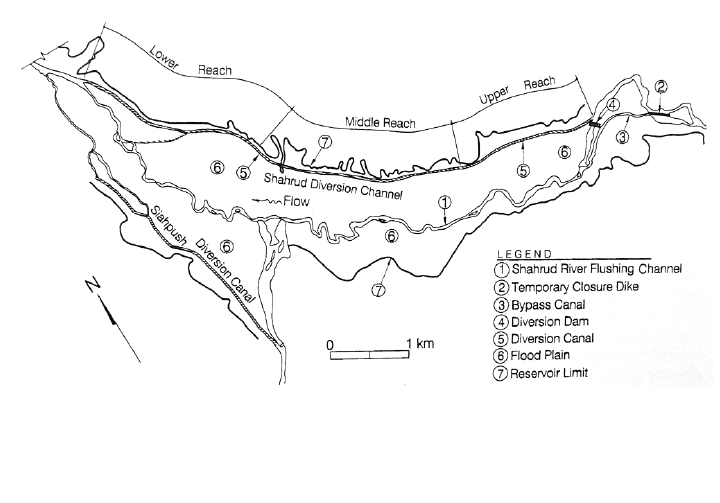
CASE STUDY: SEFID-RUD RESERVOIR, IRAN 23.19
An initial test of the diversion channel concept was made during the 1987-1988 flushing
season, using a 5-km diversion channel with a slope s = 0.005 and water diverted from
the Siahpush River, a smaller tributary. For flows between 1.2 and 2.2 m
3
/s the outflow
sediment concentration was normally increased by about 40 g/L, and during a period
with 3.8 m
3
/s of flow the outflow concentration was increased by 107 g/L compared to
the inflow. On the basis of this success, during the next year a diversion channel system
was constructed along the right side of the Shahrud River reach, the smaller of the two
main tributaries to Sefid-Rud Dam.
23.6.1 Components of the System
The Shahrud diversion system consisted of two main parts: an earthen diversion dam
and a pilot channel. The layout of the system and other features are shown in Fig. 23.17,
which also illustrates the meandering configuration that developed along the main
flushing channel.
FIGURE 23.17 Schematic layout of Shahrud reach of Sefid-Rud Reservoir showing longitudinal
diversion channels, diversion dam, and other features. Note the meandering planform of the
flushing channel.
Construction and operation of the diversion channel was undertaken in the following
steps:
1. Construct a pilot channel to define the route of the longitudinal channel to be eroded.
2. Construct a stream bypass around the site of the diversion dam.
3. Construct an earthen diversion dam to deliver all streamflow into the pilot diversion
channel.
4. When the diversion dam is completed, close the bypass and begin filling the
diversion dam.
5. Begin diverting water into the pilot canal at a rate high enough so that overtopping of
the earthen diversion dam is prevented, but without allowing the pilot channel to
overflow and thereby cause lateral erosion into the main channel.
CASE STUDY: SEFID-RUD RESERVOIR, IRAN 23.20
The initial stage of this operation is critical, when the diversion channel consists only of
the small pilot section not yet enlarged by erosion. To prevent overtopping of the diversion
channel and consequent breaching, an overflow section along the left bank of the pilot channel
was provided about 500 m downstream from the inlet to allow excess flow to spill back
into the main channel, in an area that was accessible and observable by operating personnel.
23.6.2 Diversion Dam
Several geotechnical and hydraulic considerations influenced siting of the diversion dam.
The dam site needed to be in an area where piping through the adjacent beds was not
anticipated, since this could cause an abutment to be washed out. The diversion dam was
designed as a nonoverflow structure; no spillway or outlets were provided other than the
diversion channel. To prevent overtopping and erosion of the diversion dam by flood
flows exceeding the capacity of the diversion channel after it had been enlarged by erosion,
the diversion dam was designed to be submerged every year by the rising reservoir pool prior
to spring floods. This dictated the maximum height of the diversion structure with respect to
the pool elevation.
The river bypass around the diversion dam site was dug in the form of a pilot
channel on the left bank, taking off from an area where the river was wide and braided
with a gravel and cobble bed. The pilot bypass channel was sized for a hydraulic capacity
of about 1 m
3
/s capacity, and when the channel had been excavated, the river was closed
by an 800-m-long dike about 2 m high with a 2-m top width. The amount of flow
discharged into the bypass channel gradually increased as the dike was extended farther
across the riverbed, gradually eroding the pilot channel so that, upon closure, the total
Shahrud River discharge of 12 m
3
/s could flow through the diversion channel. Two
weeks were required to construct the river bypass system.
The diversion darn was an earthen structure 80 m long with a maximum height of 8 m
above the riverbed and a 5-m crest width. The foundation was stripped, abutments were
trimmed, and mixed soil was placed in 0.3-m layers and compacted with six passes of a
bulldozer. The crest of the dam was set at 269 m, about the same level as the adjacent flood-
plain. Darn construction required about 8500 m
3
of material consisting of clayey silt
excavated from nearby sediment deposits. As necessary, layers of cohesive sediment
excavated from the diversion channel were mixed in to achieve the desired fill specification.
The dam was constructed in 2 months (November 1988 through January 1989) and
provided about 0.40 Mm
3
of upstream storage, which stored inflow during the initial days of
pilot channel operation when it could not accept the full Shahrud discharge.
23.6.3 Diversion Channel
The location of the diversion channel was selected near the right-hand margin of the
floodplain to provide access and workability for construction machinery. The canal was
7.6 km long with an average slope s = 0.0054. A canal could not be constructed in the
bottom portion of the lower reach because the unconsolidated silts and clays in this area
had almost no strength and would not support construction equipment. Therefore, in this
area discharge was simply allowed to flow across the deposits. Construction of the pilot
diversion channel required 2 months with two bulldozers and two mechanical shovels
(backhoes). Figure 23.18 illustrates a portion of the channel prior to diversion.
23.6.4 Operational Results
The most critical phase of longitudinal erosion by a pilot diversion channel is the initial
scouring, when flow is initiated through the pilot channel but insignificant erosion and
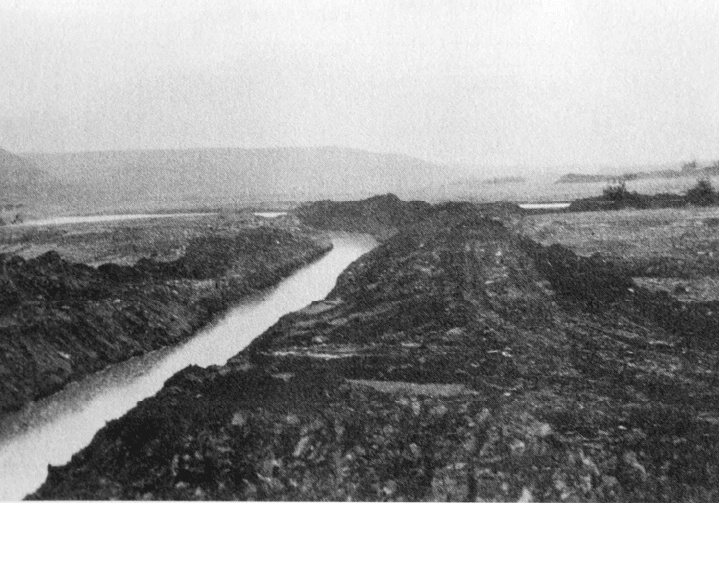
CASE STUDY: SEFID-RUD RESERVOIR, IRAN 23.21
deepening of the channel has occurred. The Shahrud bypass was closed and filling of the
impounded reach upstream of the diversion dam was initiated. Flow through the pilot
channel was initiated on January 19, 1989 with a discharge of only 1 m
3
/s, but after 10
days the river inflow had raised the water level behind the diversion dam to 266 m, and
on January 28 discharge into the diversion channel was increased to 5 m
3
/s to prevent
overtopping of the diversion dam. As erosion continued to enlarge the diversion channel,
the flow was increased, until by February 4 the entire 12 m
3
/s discharge from the
Shahrud River was being diverted.
FIGURE 23.18 Photograph of upper reach of pilot diversion channel prior to erosion (E. Tolouie).
Retrogressive erosion was the principle mechanism for scouring the diversion
channel. The shallow pilot channel followed the slope of the floodplain deposits and its
terminus was well above the thalweg elevation of the main channel. Retrogressive
erosion was initiated immediately in the weak and unstable deposits where the diversion
channel discharged into the main channel, and thence propagated rapidly upstream. Two
mechanisms were observed by which retrogressive erosion accelerated erosion: plunging
flow occurred at the upstream headwall, causing intense undercutting in an action similar
to that associated with gullying, and flow acceleration in the reach extending as far as 200
m upstream from the point of plunging flow caused visibly accelerated erosion and
turbidity increase. The erosional pattern was affected by two thick layers of cohesive
sediment which formed erosion-resistant layers, as illustrated in Fig. 23.19a. Erosion
proceeded upstream along the upper clay layer at about 100 m/day, but at a slower rate
along the lower layer. However, in the lower reach of the channel where the deposits were
not well consolidated and stratification was largely absent, erosion by layers was not
detected. The appearance of the area of active retrogressive erosion, the "nickpoint," is
shown in Fig. 23.20.
Only small bank slides occurred in the middle and upper reaches during the initial
phase of diversion, with only 1 m
3
/s of flow and a small bottom slope. However, when
discharge was increased to 5 m
3
/s, the erosion rate increased dramatically and frequent
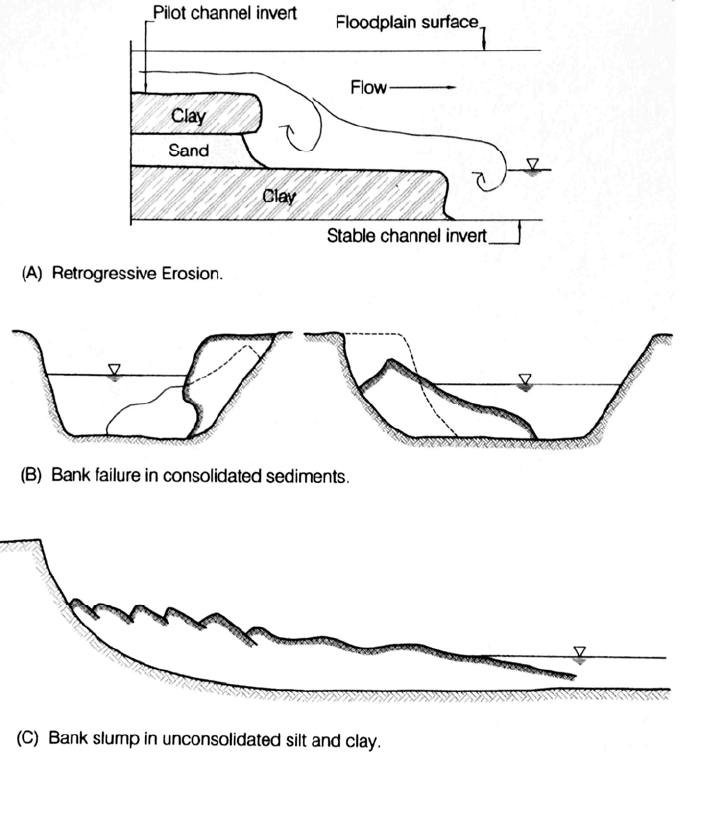
CASE STUDY: SEFID-RUD RESERVOIR, IRAN 23.22
FIGURE 23.19 Erosion patterns observed in Shahrud diversion channel: (a) retrogressive
erosion in layered sediment, (b) block failures in middle reach, and (c) slumping of weak deposits
in the lower channel. (after Tolouie, 1993).
d
eep slides were observed, at the rate of about one per minute. This continued until the
canal became partially submerged by reservoir impounding in February, and resumed
again when the reservoir was lowered for flushing in the subsequent year.
Banks slid into the eroding channel by slumping in areas of poorly consolidated and
saturated sediments, or as the collapse of larger blocks in areas of more consolidated
sediment (Fig. 23.19b and c). There was a noticeable increase in bank sliding as
discharge increased. Blocks of consolidated clays that fell into the channel were
transported downstream as bed load, and thus part of the load of fines was not sampled by
suspended load measurements. The photograph in Fig. 23.21 shows the massive
slumping process along the lower part of the diversion channel, as contrasted to the
higher bank angles characteristic along the middle reach shown in Fig. 23.22. Bank sliding
was particularly evident when the diversion channel emerged as the reservoir was
emptied for the 1989-1990 flushing because of factors such as higher pore pressure in
the saturated bank material and seepage. The diversion channel appeared to have
